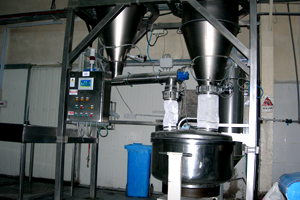
Dosing
Dosing and accumulation units are an important part of our production, thanks to which it is possible to reach any point in the production layout, both with continuous and batch dosing, and with individual products as well as with recipes containing several products. Thanks to the many types of application, our systems make the raw materials available when and where they are required.
 Hoppers
Hoppers
 Dosing the product that is stored in the silos can be done using one or more weighing hoppers. This is a key component as it allows the product to be weighed with a precision of 0.03% of the system full-scale. It is possible to weigh individual products or different products simultaneously either in the same hopper or in different hoppers. Once weighed, the product can be easily unloaded in a kneader, a mixer, or conveyed in a pneumatic line to be transferred to a different work area.
Dosing the product that is stored in the silos can be done using one or more weighing hoppers. This is a key component as it allows the product to be weighed with a precision of 0.03% of the system full-scale. It is possible to weigh individual products or different products simultaneously either in the same hopper or in different hoppers. Once weighed, the product can be easily unloaded in a kneader, a mixer, or conveyed in a pneumatic line to be transferred to a different work area.
 Accumulation Stations
Accumulation Stations
In order to ensure a precise and immediate dose it is necessary to accumulate the product, especially in cases in which a packing machine, a mixer or any continuous process is being fed. Thanks to the many types of application, our systems make the raw materials available when and where they are required.
 Micro Dosing
Micro Dosing
 Precision micro-doses for preparations and semi-finished products. The product is weighed and sent to another processing phase by means of a pneumatic line. Available in both volumetric and gravimetric versions with a load cell weighing system that ensures precision and reliability: they are available in various configurations suitable for treating powders and granules with different
fluidities and densities.
Precision micro-doses for preparations and semi-finished products. The product is weighed and sent to another processing phase by means of a pneumatic line. Available in both volumetric and gravimetric versions with a load cell weighing system that ensures precision and reliability: they are available in various configurations suitable for treating powders and granules with different
fluidities and densities.
 Liquids
Liquids
 A wide range of stainless steel storage tanks, temperature-controlled tanks for storing oils, fats and all temperature sensitive products.
Tanks with refrigeration units for storing eggs, milk and yeast. Tanks made from AISI 316 stainless steel for storing saline solutions. Use of easily inspected sanitary pumps, high-reliability sanitary valves to satisfy the strictest sterility and hygienic requirements. Automatic or semi-automatic C.I.P. washing units. Accurate dosing of high and low viscosity liquids.
A wide range of stainless steel storage tanks, temperature-controlled tanks for storing oils, fats and all temperature sensitive products.
Tanks with refrigeration units for storing eggs, milk and yeast. Tanks made from AISI 316 stainless steel for storing saline solutions. Use of easily inspected sanitary pumps, high-reliability sanitary valves to satisfy the strictest sterility and hygienic requirements. Automatic or semi-automatic C.I.P. washing units. Accurate dosing of high and low viscosity liquids. 